



1947-2022


 An unwavering line to the horizon, Savin Construction Corps carves straight through Wells in the fall of 1946.
An unwavering line to the horizon, Savin Construction Corps carves straight through Wells in the fall of 1946.







1947-2022


 An unwavering line to the horizon, Savin Construction Corps carves straight through Wells in the fall of 1946.
An unwavering line to the horizon, Savin Construction Corps carves straight through Wells in the fall of 1946.


I quickly understood, when I joined Maine Turnpike Authority in 2011, that a historical perspective was and still is the critical guide to planning effectively for the highway’s future. Ever since the road started, so many things get built, redesigned, changed, and rebuilt that the physical structure and the organizational structure of the Turnpike have been in a constant state of productive flux.
We all need to appreciate how those changes came about and how things evolved over time in order to weigh in on how to manage the flow greatest flow of vehicular traffic that exists in the state of Maine.
In 75 years, we’ve gone from hand-to-hand exchanges of paper tickets and cash to open road tolling systems that conduct the same transaction as vehicles travel 70 mph. We’ve gone from unwieldy, paper road maps to builtin talking GPS devices. What the newspapers heralded as Maine’s first milea-minute superhighway has kept pace with the evolution of road building science and engineering so that today the Maine Turnpike is faster, safer, and more self-sustaining than thought possible in 1947.

Mainers can take justifiable pride in the history of the Maine Turnpike as its contribution to the state’s economic health and the state’s unique
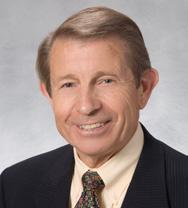 Mills Executive Director
Mills Executive Director
But the truly inspiring aspect of this story is the Maine men and women who made and continue to make the Maine
Space does not permit me to list even the jobs, the tasks, the designs, the math, the heavy lifting, and the long hours that thousands and thousands of Maine people have applied to make commuting, commerce, and leisure travel commonplace on this venerable stretch of road.
Whenever you travel with us, I hope you will take a moment to appreciate and be thankful for all of our team members at Maine Turnpike Authority, past and present, each of whose life’s work will forever be a part of our story.
 Peter Mills Executive Director
Peter Mills Executive Director

It was the “rusticators” who came early to Maine, lured by the raw natural beauty of our forests, our coastline, our way of life. Affluent artists, writers, hunters, anglers, and campers made the long trek by steamship, by train and trolley, and often only the final leg by automobile to experience the pure air, the wild outdoors that Maine excelled in offering.

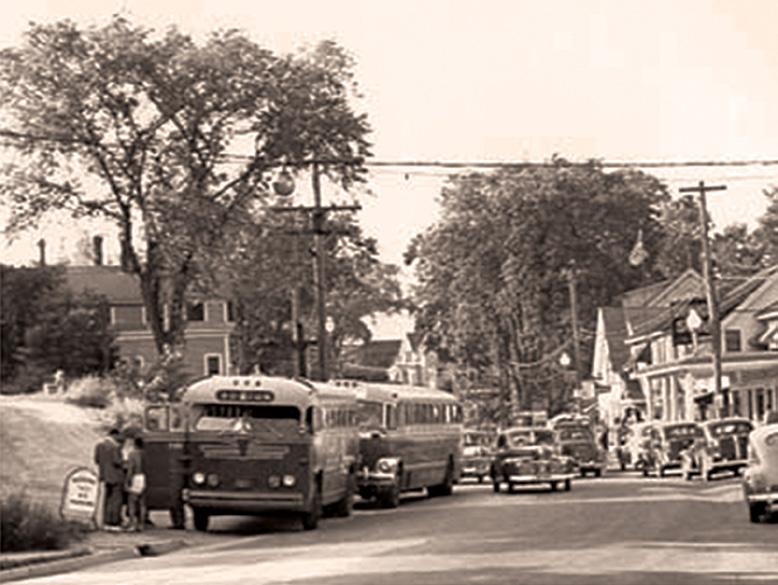
But by the 1930s, more dependable cars and, more important, more dependable roads outstripped those mass transit options, and the drive to Maine was on. By 1940, the flood of traffic choking Maine’s southern stretch








of Route One had become a major headache, requiring a good half day to drive from Kittery to Portland — a bitter pill for frustrated locals and timecrunched tourists alike, not to mention a detriment to the state’s vast number
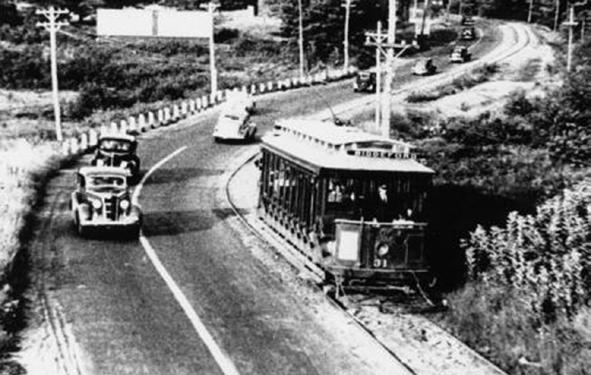
of retailers receiving northbound goods and manufacturers shipping their products out of state.
And then one night, in the winter of 1941, three men spent an evening at the Augusta House Hotel discussing a plan for Maine to solve the Route One dilemma once and for all.
Maine










The visionaries who guided the Maine Turnpike’s initial creation should still be household names: Joe Sayward, State Rep from Kennebunk, George Varney, Speaker of the Maine House, and attorney George Lord from the state highway commission, who sparked the idea in 1941. Governor

H.D. Harding, District Manager for Esso and Joe Sayward, the Turnpike Authority’s first chairman review plans for the Howard Johnson’s/Esso service plaza in Kennebunk.
Sumner Sewall signed it into law. Governor Horace Hildreth designed the financial plan to make the Turnpike self-sufficient.
The Maine Turnpike Authority became official.



And then, the attack on Pearl Harbor brought America into World War II and put the Turnpike project on hold. Immediately after the war’s end in 1945, workers broke ground, and hundreds of Mainers — highway engineers, surveyors, road construction contractors, heavy-duty equipment operators, pick-and-shovel crews, truck drivers, paving contractors, bridge builders — many of them veterans — carved, graded, and paved the 47-mile pathway to the west of Route One.
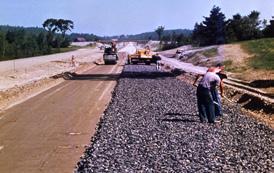








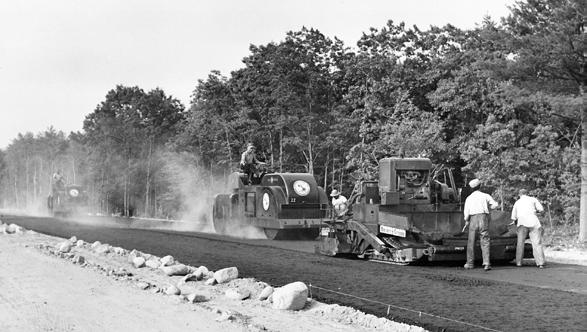

“
After you’ve been in an office for 35 years, you don’t want to be in an office again. So I wanted my
booth. You don’t have
own toll
the pressure and people and all that.
I
enjoy people and so forth, believe me, but being on the toll road, that’s what I enjoy because I enjoy the outdoors too. Whether it’s rain or sleet, it doesn’t bother me really, because I enjoy going to the Turnpike.’’

Paid for then as it is today entirely with user tolls, the Maine Turnpike opened on December 13, 1947. It was America’s second superhighway — after the Pennsylvania Turnpike — the world’s first asphalt highway, Maine’s first “Mile-A-Minute” highway — a beckoning new, express, high-speed auto road with its own restaurant, gas and service stations, road side assistance, and toll booths attended around-the-clock.
As the Turnpike gained notoriety, revenues increased 160 percent over the first four years, and the undertaking’s bond debt was retired ahead of schedule.

American-style comfort food and 28 ice cream flavors made swinging in to “Ho-Jo’s” so much more than a rest stop; it became a very popular destination on its own.
Approaching 1955, U.S. car ownership had grown to 70%. The original 47-mile Turnpike showed how it was done. And Maine Turnpike Authority set its course for a new horizon.
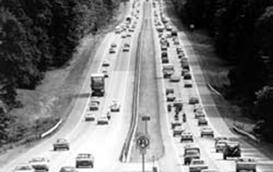






 Philips introduces dash-board cassette tape player.
Philips introduces dash-board cassette tape player.
In less than five years of Turnpike operation, doubling the highway’s length gained enthusiastic and widespread support. In 1954, the addition of 66 new miles took place in breathtaking time despite some of the worst weather imaginable: the wettest in 50 years.
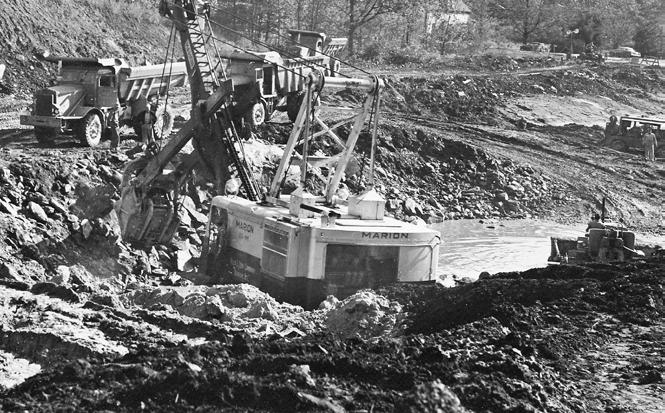
In 154 working days, it rained 97. Over ten days, Hurricanes Carol and Edna lashed Maine with two and a half feet of rain. Slogging through rivers of mud, construction crews managed to get the job done, laying four lanes of asphalt from Portland to Augusta.
On December 13, 1955 — the eighth anniversary of the KitteryPortland opening — Governor Ed Muskie officially opened the Maine Turnpike extension, unveiling a 113-mile modern superhighway from the New Hampshire border to the state capital.
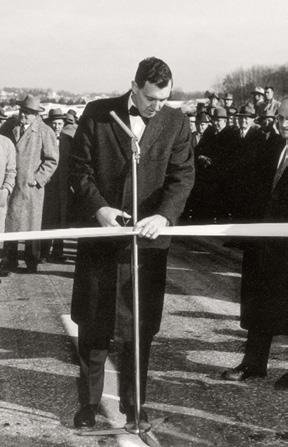

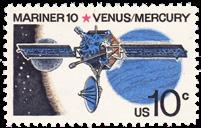



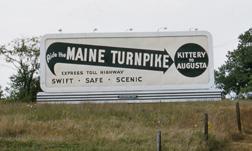

In 1956, 3.8 million vehicles traveled the highway. By 1997, more than a million per week. And hundreds of Mainers — toll collectors, maintenance crews, snowplow drivers, office workers, administrators, state police, gas station attendants, service plaza staff — worked 24/7 to make the Turnpike run.
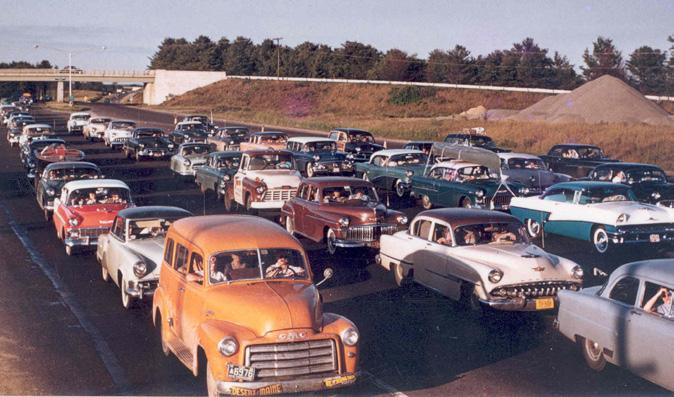
From its beginning the highway has always been a work in progress, as Maine Turnpike Authority continually improved on the original design, adding breakdown lanes, side guardrails, and median strip barriers for greater safety. Road surface maintenance and repair work, winter storm cleanup, and summer landscaping became the perennial tasks of keeping the Turnpike the fittest for high-speed travel.
Eighty to 90 percent of all goods and services coming into the state come on the Turnpike. And if you’re trying to keep more goods and services coming into the state and keep a good solid economy, the Turnpike is that backbone. So it’s our mission — because we’re Mainers and we do care about Maine — to try to keep costs low and keep the road high quality.’’



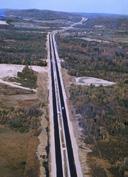





Originally, the plan was to retire the Turnpike’s investment bonds in 1982, eliminate the tolls, and have the Maine Department of Transportation take charge of the highway. But by 1981 MaineDOT found itself bullied by financial headwinds. The 1973 Arab oil embargo and the Iranian hostage crisis of 1979 drove gas prices from 35¢ a gallon to $1.40, the popularity of smaller, high mileage cars soared. Gas sales and gas tax revenues plummeted leaving MaineDOT millions of dollars short of covering its own annual expenses.

Work
zone safety is super important. I’ve really taken that to heart, and when we remind people to go slow in a work zone, we mean it. Those are our friends and our colleagues out there working on the road. Traffic is whizzing by, it’s loud, it doesn’t feel safe. Every April, there’s a nationwide Work Zone Safety Awareness Week, and we promote that as much as we can to get the word out but also to let those folks out there on the road know that their safety is topmost in our minds.’’
Saddling the DOT with responsibility for the Turnpike was out of the question, and Maine’s Legislature, noting that out-of-state drivers paid more than half of the Turnpike’s expenses, voted to allow the Turnpike to remain independent, offer volume discounts, and turn over 25 percent of its revenue to cover the MaineDOT shortfall.



The pace of change accelerated as Maine approached the century’s end. In 1987, officials in Augusta authorized a widening of the Turnpike to three lanes in each direction. In 1990 construction started up on the expansion. In 1991, Maine voters halted that effort through a
citizen referendum.




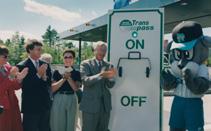

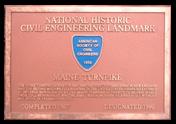
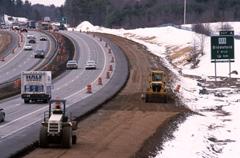
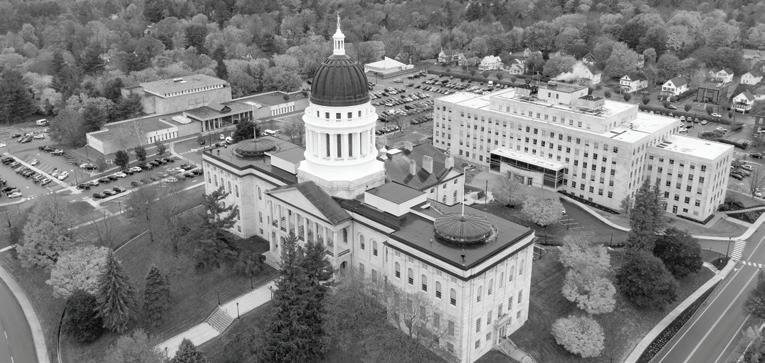


In 1992, as gas tax revenues continued to fall short of financing the state’s roadway needs, the legislature upped the Turnpike Authority’s annual MaineDOT payment to $5 million. In 1994, $16 million. In 1996, $35 million with payments spread over ten years.
Since then, the Turnpike has provided more than a quarter billion dollars to MaineDOT, supporting roadway construction, bridge building, and safety improvements throughout the state.

By 1997, at the 50th year milestone, the Turnpike was performing near its full capacity with all traffic predictions forecasting much more to come.
Talk of expanding the Turnpike, an ongoing debate since 1972, became loud and clear as Maine’s premier economic artery surpassed the half century mark.







By age 50, the Turnpike was clearly the “go-to” route from Kittery to Augusta. Maine had grown, too, with a population 50 percent larger than when the highway opened in 1947.
More people, more visitors, more commerce — the increase in traffic called for continuous improvement and innovation for Maine’s premier highway.

In 1997, Maine voters overwhelmingly approved a ballot initiative to allow a widening of the Turnpike. From York to South Portland, 30 miles of two-lane highway were expanded to three lanes with every single bridge in between widened accordingly.
That same year, the Turnpike unveiled “Transpass,” an automatic, electronic toll collection system enabling true, non-stop travel. Now known as E-ZPass, today it lets drivers pay tolls automatically in 17 states.
In 2013, a leap in toll collecting technology landed with the addition of “Open Road Tolling” gantries. E-ZPass drivers now cruise through specially designated lanes at highway speed with their toll payments processed in nanoseconds.
Most recently the Portland Area Widening project has placed expansion back on the Turnpike Authority’s radar. From Mile 44 to Mile 49, construction is under way, again from two lanes to three and a substantial redesign of Exit 45.
And with the 2021 opening of the new, gateway toll plaza in York, featuring six lanes of high-speed







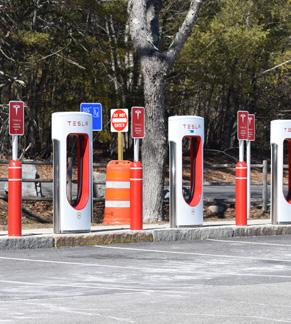
E-ZPass tolling, driver convenience and traffic flow have never been better.
More growth, more progress,
Vacationland’s soaring popularity — faster cars, bigger trucks, improved traffic interchange designs, electric car charging stations, smartphone GPS — there’s no end to the changes driving the Turnpike’s evolution.
What will the next quarter century bring? A whole new class of vehicles? Self-steering? Airborne vehicles? Who knows?
We do know that behind it all will be, as they always have been, the millions of Turnpike users whose tolls have always paid for it all and the hundreds of people at the Maine Turnpike Authority who will always make it all work.
If you look at some of the communities where the Turnpike runs, they’ve thrived because they have easy access to the rest of the region. If you live in a community that has a Turnpike exit, it’s right at your fingertips. You can just get in the car and go. That helps communities with economic development. You get a lot of benefit from having the Turnpike in your backyard.’’
































































































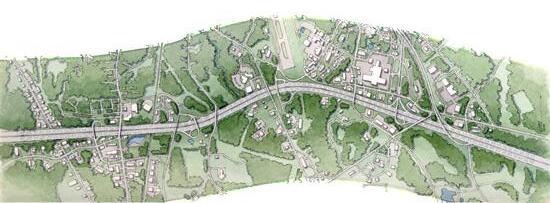


In the years leading up to the opening of the Maine Turnpike and continuing into the 50s and 60s, many of Maine’s traditional industries began to stumble.


First to falter were the textile mills, dating back to the 1850s. Shipbuilding suffered. Then shoemaking and seafood canning. The lumber industry lost out to Southern mills. Half of Maine’s farms sold or closed. The paper industry shrank. Maine had always had its tourists. It was the enviable, nineteenth century summer destination for a relatively few who had the wherewithal and the leisure time to make the arduous trek to Maine. The wealthiest owned grand summer homes along the coast.

And by 1940, with half of Americans now owning cars, Maine’s popularity had grown. Still, it took time and money to enjoy traveling to and through Maine. And summer traffic on Route One could be miserable.
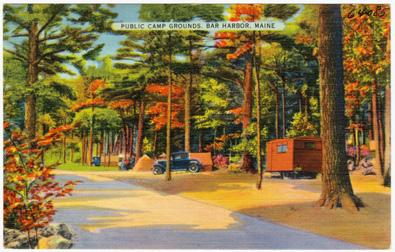
In the earliest days of motoring to Maine, the journey could be an adventure of its own but the memories were often priceless.
But then, hand in hand with post-war prosperity, the new Maine Turnpike widened the gates to an explosive growth in tourism. Overnight, the Turnpike made Maine vacations affordable for the average American family. Affordable and effortless with a non-stop express route to Maine’s beaches, lakes, mountains, and more.
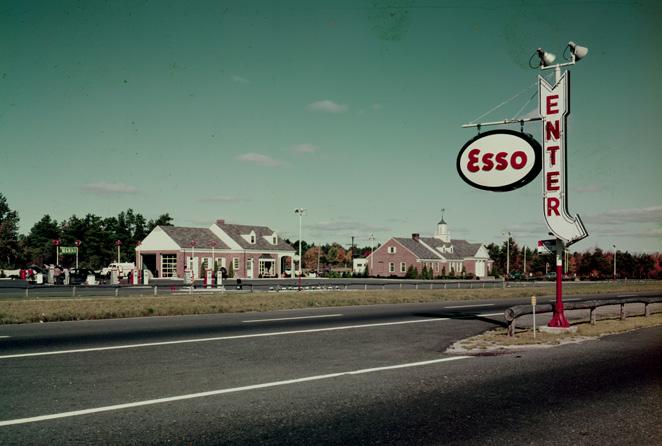
Imagine the excitement in southern New England, New York, and New Jersey as word spread: there’s a new, fast modern highway that drives deep into Vacationland.
In the 1800s Maine played its part in the Industrial Revolution, but it wasn’t meant to last.The Turnpike continues to be the primary roadway for tourism, now an $11 billion industry, Maine’s leading economic driver, directly supporting roughly 16 percent of all jobs in Maine, which generate more than $2.5 billion in household income.

In 2021, more than 70 million vehicles traveled the Maine Turnpike: weekly commuting traffic, four-season tourist traffic, mass transit buses, emergency vehicles, trucks of all sizes exporting Maine goods to southern markets and importing products for Maine consumption.
In so many ways, the Maine Turnpike touches the lives of most of the state’s residents. Whether they travel the highway or not, the food that graces their tables, the appliances that improve their homes, and the customers that
patronize their community’s businesses all make their way on the Turnpike and make Maine’s economy stronger.
What’s more, vacationing motorists from out of state pay two-thirds of the toll fees collected on the Maine Turnpike.

Today, it seems that Maine is on everyone’s bucket list. History has shown it was the Maine Turnpike — the right idea at the right place at the right time — that helped make “Vacationland” world famous — and rejuvenated the state’s economy.
From the start, the Turnpike Authority’s responsibilities stretched beyond the highway to include building and maintaining all of the bridges carrying the preexisting roads above it.

Where Route One followed a string of thriving coastal towns, the Turnpike’s original path traveled through rural farm fields and forests a few miles inland of the seaboard.

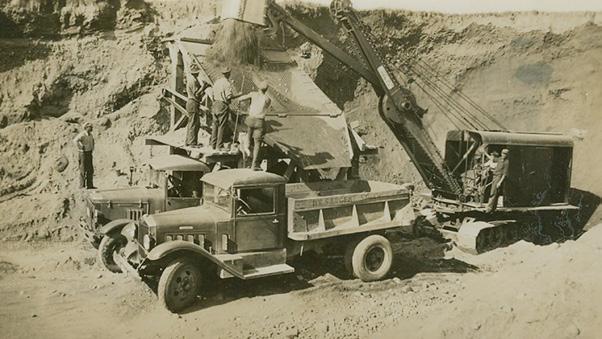
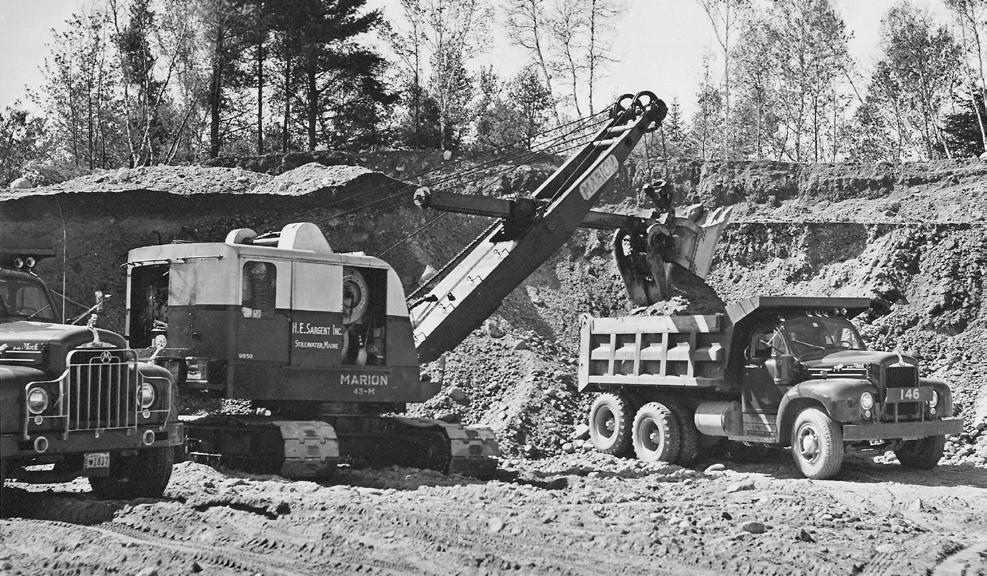
Creating a superhighway had been done once in the U.S. The confidence that that success could be repeated here spoke volumes of Maine’s character and determination.
In the winter of 1947-48, with toll booths squaring off against all of Maine’s weather extremes, a short stack of firewood was a toll collector’s closest friend.

Passenger cars paid 50¢ to access the brand new Kittery-Portland highway. That first year, the Turnpike welcomed 1,500,000+ customers, less than a week’s worth of today’s traffic volume.
In 1948, Howard Johnson’s, the orange-topped oases for America’s motoring public, added 200 new locations nationwide, our Kennebunk Service Plaza’s Ho-Jo included.


From 1930 to 1950, Boston’s Tichnor Bros, Inc. published some 25,000 “colorized” postcards of popular American vacation spots with nearly a dozen promoting the new Maine Turnpike.


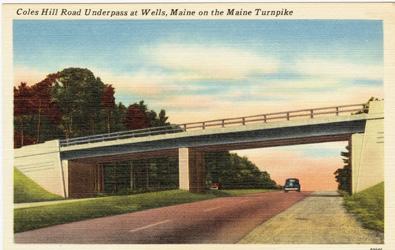



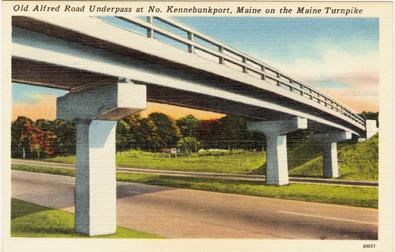
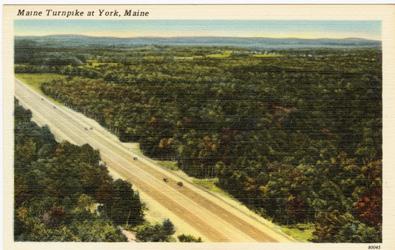

After two hurricanes dropped 2.5 feet of rain in ten days’ time, the quest for the Portland-Augusta Extension became a wicked muddy challenge.
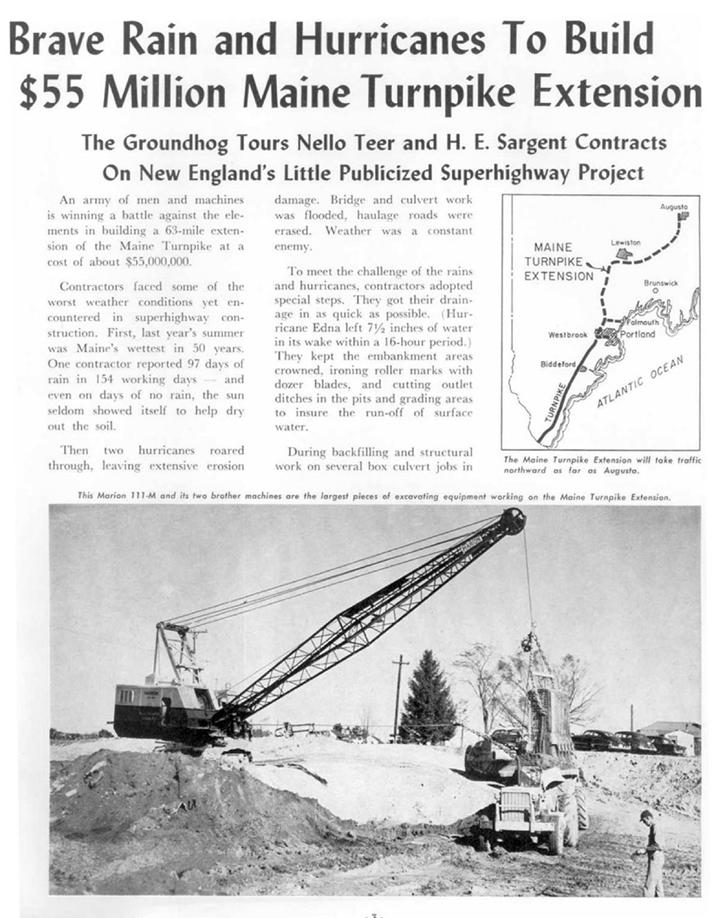

Keeping the Maine Turnpike as flat and as level as possible played into the design for safe traveling. So the road would not roll over bedrock; it would go through it.

A highway crew uses a mechanized hole digger to place wooden posts along the Turnpike’s shoulder, auguring an evolution toward today’s far safer guardrail systems.

Forty-foot concrete piers await 12,000 tons of Pennsylvania steel decking needed to complete the 846-foot Androscoggin River Bridge, the longest of 91 bridges built during the 1955 effort.

Compare this photo, taken before median and roadside guardrails became routine, with today’s highway designs. We had much to learn in managing a safe superhighway.


Next time you’re on the Turnpike, note the long, straight stretches and gentle curves that minimize the likelihood of vehicle accidents and permit high-speed driving.

Boomers might remember. For years, northbound travelers could stroll through a tunnel below the roadway to get to Howard Johnson’s on the Turnpike’s southbound side.

Who remembers toll tickets? A different ticket for every exit showed the different costs for traveling to all the other exits. The toll
1997.
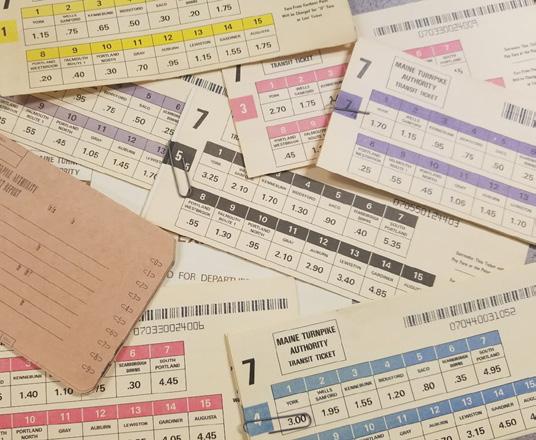
The State of Maine Publicity Bureau’s 36th edition of “Maine Invites You” featured this ad extolling the virtues of the Maine Turnpike. Fifty years later, the copy still rings true.

During the 90s the need to expand the Turnpike’s southern section became obvious and, in a 1997 statewide referendum, Maine voters overwhelmingly agreed.
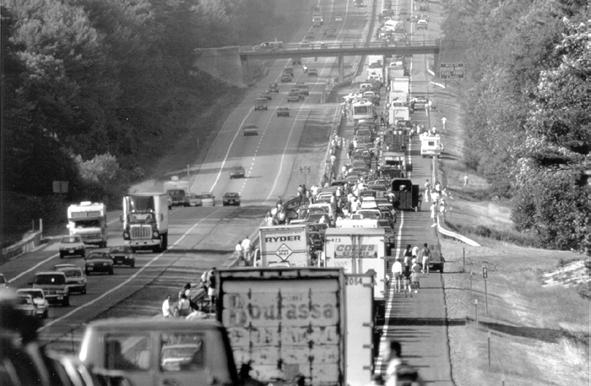
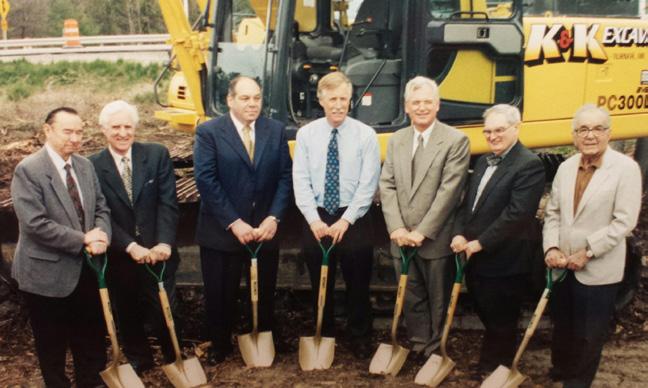

From May of 2000 through 2005,



The Turnpike’s second major growth spurt began in 2019 with the Portland Area Widening effort. Spurred once again by increased traffic congestion, the Turnpike Authority undertook a new expansion from Mile 43 in South Portland to Mile 48 in Falmouth.


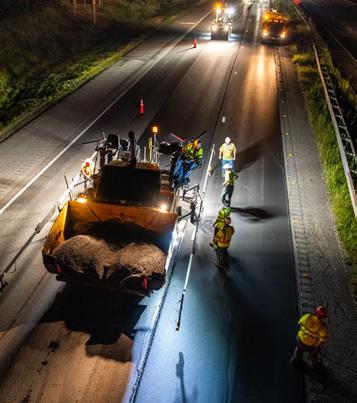
Whatever the season, the Turnpike is a scenic corridor edged by forests, crossed by major rivers and quiet streams, beckoning every traveler with an unmistakable hint of Maine’s natural beauty.



U.S. electric car registrations increased 60 percent in the first quarter of 2022, and we are keeping pace with EV charging stations available at our service plazas since 2018.

Driver convenience is a plus thanks to our upgrade to automatic, high-speed tolling. Enhanced safety is another plus as rear-end collisions are more likely in stop-and-go traffic at cash toll booths.

 Six lanes of early evening travelers stream along the Turnpike just north of Biddeford’s Exit 32.
Six lanes of early evening travelers stream along the Turnpike just north of Biddeford’s Exit 32.

Some improvements can be truly visionary. In 2021, our snow plows added green flashing lights because ophthalmological studies showed that green light is the easiest to see.

A 1956 ad predicted many of the amazing automotive innovations we see becoming realities today. As it has for 75 years, Maine’s future will be riding on the Maine Turnpike.
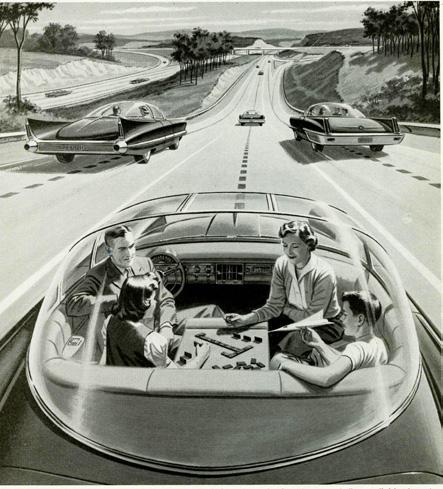
 MISTY BENTHAM Toll Supervisor
MISTY BENTHAM Toll Supervisor
My mother was employed here at the Turnpike Authority prior to me, and I graduated from high school in 1995 with big plans to go out west to follow the Grateful Dead. And in the summer of that year, Jerry Garcia passed away so I was in a scramble to try to figure out what I was going to do with myself from that point forward.
I got hired in December of 1995, and here I am.
I loved working in the tolls. I love being a toll collector. I love the people. I love engaging with the public. Now I’ve been able to have a couple of promotions and get into the supervisory side and the management side of the company, which I’ve enjoyed just as much.
Being superintendent for fare collection can be a little bit challenging because as the toll workers are out there around the clock, we are, too, because they need to have somebody to be able to contact if there’s something going on out there on the road or in the booth while we are on duty.
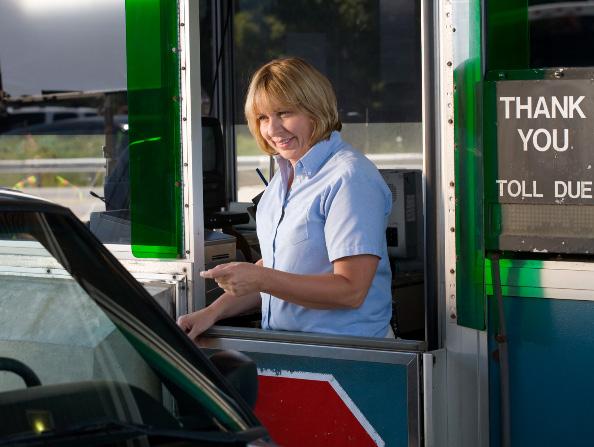
We are trying to provide a good service to people out there as far as maintaining roads and toll collectors, too, having a good attitude, giving off good customer service. You don’t know a lot of times what’s going on in people’s day when they come through and they pull up to your lane. So sometimes if I can influence something positive before they leave my lane, that makes my day to give something back, to put a smile on somebody else’s face.
That’s what makes the difference. That’s what makes that transaction and that interaction different, memorable even. Like, “Geez, every time I go to Maine, they have the nicest toll takers.” I’ve heard that a lot. It’s nice if we can do that one little thing and make their travel here a positive experience for them.
I think it’s really important to have good customer service out there, to interact positively with the public, because you make friends, so to speak, with some of the regular customers that you have. And I just enjoyed it immensely.
 PETER MERFELD, P.E. Chief Operations Officer
PETER MERFELD, P.E. Chief Operations Officer
As the chief operations officer, I am responsible for maintenance of the facilities, the highway, the bridges, also the engineering program, the selection and overseeing of the consulting engineers that do the design work, the construction out in the field, the construction that’s ongoing, the folks that are responsible for inspecting the work, the service plaza operations dayto-day, and also public safety.
I think a lot of people don’t realize that the Turnpike has a state police troop, Troop G, that’s assigned to the Turnpike. They’re in our office building in Portland.
The Turnpike Authority, and different people have said it in different ways, but it’s the lifeblood of Maine. The road brings in the majority of commodities and products that we use in the state and the products that need to leave the state.

I think a lot about what’s happening on the highway when it’s snowing out. Anything can happen. We’ve got folks out there that are taking care of the roads 24/7. When folks are working, especially in situations where there’s some risk, it is hard to sleep knowing they’re out there. You’re always concerned about your employees’ safety, the travelers’ safety, and trying to do our best to keep traffic moving.
There’s a big team involved; it’s obviously not just me. It’s a lot of different folks doing different things. And I think that teamwork and keeping the road open and keeping traffic moving and making sure it’s safe is our goal, and we’ve been fulfilling that for 75 years. And I would think for the next 75 years that we would continue to do that.

 MBOB HOOPER Toll Collector
MBOB HOOPER Toll Collector
y grandfather Hooper—I remember seeing the paper, and I was about 10 years old, and he was telling me about how they were going to build a Turnpike and it was going to be so straight, and they needed gravel and so forth.
So we owned about 500 acres of land in York, my great-grandfather’s, and that came down through the family, and so what we did was we sold gravel to the Turnpike.
We went out to this field and he put his shovel in and he had gravel on it.
He knew what was underneath the ground so he scooped out the gravel and we sold a lot of the gravel to the Turnpike. So that’s why down in the York area it’s the “Hooper Road.” It’s been part of my life for a long time.
I still work in the tolls or I work on the Falmouth Spur, and I’ve been here over 25 years, now. It was almost impossible in

the wintertime to come down through Route One. It was a very slow trip.
When the Turnpike opened it became that much closer. We went from rural
Maine to being a state that would bring a lot more people in for industry and vacationing and everything. Really.
I tell these college kids get a job that you like to go to, you know. And so I enjoy going to the Turnpike—a lot of it.
Older people, or even younger people, are very nervous that they’re lost, you know. I’ll say just tell me where you’re going, I’ll get you there in half the time but stay on the Turnpike.

 AJODY DYKE Engineering ANDY DYKE
Maintenance Foreman, Gray
AJODY DYKE Engineering ANDY DYKE
Maintenance Foreman, Gray

ndy: My grandfather plowed snow in Gray maintenance, in that area.
Dad plowed snow in the Gray area. I plowed in the Gray area, and now I’m overseeing the Gray area.
Jody: The three of us actually worked out of the same garage bay. I grew up hearing the stories from my dad. He grew up hearing the stories from me. I can remember him telling me the stories about how guys had to stand in the back of the truck and throw the sand out by hand. And now you just cruise down the road and push a button and it all happens for you. So, yeah, we’ve evolved quite a bit.
Andy: I just always wanted to be out on the road, curious, young, you know, everyone wants to be like their father and here I am.
Jody: It’s not as routine as one might think. I mean, it’s ever-changing, constantly changing. The wants and needs of the roads and what the road requires as our traffic numbers go up and we get more and more people driving the road, we’ve got more stringent safety measures to meet.
Andy: We sustain a very, very clean road and make sure that our reputation is kept to that high standard that the patrons expect from us.
Jody: I don’t think either one of us drives the road without looking to see what could improve. It’s just instilled in you. You do it every day so you kind of can’t help but do it in your off time. It’s a great place to work, actually.
Andy: Absolutely. We are a Turnpike family.
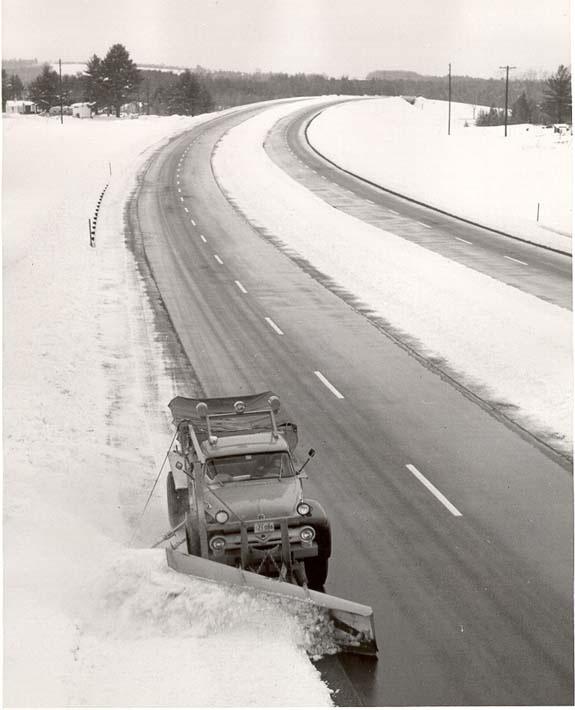
 DOUG DAVIDSON CFO / Board Treasurer
DOUG DAVIDSON CFO / Board Treasurer

Amazingly enough, a lot of the turnpikes were all created around the same time, and they all had a very cookie-cutter way of trying to do their finances. For example, most of them didn’t issue any debt longer than 20 years, and they were hitting the worst part of the yield curve.
So I was one of the people that was trying to convince them to issue longer debt. If you’re building a road that’s going to have 50 years of life, why not issue 30-year debt or something longer, and that way the people who are getting the benefit of it are actually paying for it and it allows you to do more projects.
So we issue these bonds. Instead of putting money in banks—the swifts or New York or something—I go to all the small banks here and put the money in the small banks so that the money is working in Maine.
And one of the things that the rating institutes always say about the Maine Turnpike is you come out with a plan and you always follow your plan and you do what you say you’re going to do. And that builds confidence. We’re in the top three rated turnpikes in the country. We have a AA or AA-minus credit rating across the board. And it gives you pride to know that Maine, a small state, can actually be a leader like that, that we’re within the top three.
We pride ourselves in trying to keep our rates as low as possible because we’re all Mainers and we don’t want to drive business out of Maine.
Most everyone else, their rates are significantly higher. I don’t want my children or anybody else’s children having to move away to get a job. That’s really my underlying motivation.
Realistically, no matter what your organization does, it’s all about people. It’s all about your customer. And even though we kind of have three different customers—we have the bondholders, we have the state itself, and then we have our traveling public that’s on the Turnpike—sometimes it’s hard to please all three, but it’s our mission to try to do the best to please all three.
When you’re always trying to modernize and cut your costs, you can afford to do more projects. And I always say that the people who are in charge of the Turnpike want it to be safe in a snowstorm, they want to see that the bridges are nice and safe and maintained, and they want people to be able to travel at normal highway speeds, but they also want drivers to pay a low price. If you put that all together, it’s a winning combination. I think it’s a mission of the organization as a whole is to try to help Maine.
 REBECCA GROVER Public Outreach Coordinator
ERIN COURTNEY
Public Outreach Manager / Legislative Liason
REBECCA GROVER Public Outreach Coordinator
ERIN COURTNEY
Public Outreach Manager / Legislative Liason
Erin: Every day is different working in public outreach. There might be some days where you’re working on putting out a press release about traffic, about the upcoming holiday weekend, or what’s going to happen with snow coming, or the importance of E-ZPass.
Rebecca: I work with different people every day. If you write in to the Turnpike and you have a question or a complaint, that’s me that you’re getting, I am that person. You know, somebody might write in and say, I lost a kayak off the top of my car. Did anybody find it? So that would be something that I would be working on.
Erin: We work with municipalities, also work with the legislature when they’re in session, making sure that they know what we do, and working with the transportation committee, either testifying in favor of certain bills or opposing certain bills.
Rebecca: When you talk public it’s every sort of part of the public, whether it’s just somebody who’s traveling the road, it can also be a town manager, a town planner, a public works director. It can be a legislator. It can be somebody who works for another engineering firm. And we’re out there to

get the word out to everybody whether it’s newspaper, radio, social media, TV interviews, whatever we can to do to get the word out.
Erin: Working in public relations is very interesting because you do have to work with so many different departments here at the Turnpike. There is a lot more to the Turnpike than just the road. And it’s not just that you work on this road and you plow a road. There’s so much more that goes into it.
Rebecca: One thing I wish people would know about the Turnpike or understand more about the Turnpike is that it is paid for by the people who use it. If you’re not using the Turnpike, you’re not paying for it. We do not get any tax money; we do not get any federal money.
Erin: One of the other things that people don’t realize that we spend money on at the Turnpike is Troop G—we support an entire state police troop, the troop that goes up and down and patrols our Turnpike road. We pay for that.
It’s very exciting to come to work and get to work on so many different elements. It’s not just that I’m, you know, “marketing,” you’re making sure that people understand the importance of the Turnpike itself and what we bring to the state.
 RICK BARRA Director of Fine Collection
RICK BARRA Director of Fine Collection
In June of ‘70, I got a full-time position at Wells Toll, and I was there for 11 years. Everybody was in uniform. Very strict uniform policy. Summer, winter clothes; they outfitted you to the nines. Eisenhower jacket with the lapels, really official, and you had to wear a tie.
I’ve loved the Turnpike. I’ve loved working for the Turnpike all these years. It’s been a great career, and I’m one of the few people who started right out of high school and is still here. It’s been wonderful. It’s been a great ride—so to speak.
We have a great staff of toll collectors out there. You’d be surprised how many people still like to stop and pay the toll and see the toll collector and get a good-morning, have-a-nice-day greeting from those of us in the booth.
Handing out toll tickets, I had so many great patrons go through. They’d appreciate you. How are you doing? Good. How’s it going today? Good. You had that every day. You’d hear their stories, you know, life stories. Those are the things that I remember the most and really relish knowing that you make an impact on someone’s life, even though it’s 10 seconds. That’s all it takes to make someone’s day. That’s why you’re here. You’re representing the Turnpike, and it’s an important job.
 PETER MILLS Executive Director
PETER MILLS Executive Director
Iwas out in the woods, cutting ski trails, and my phone went off and somebody said, we need somebody to start running the Turnpike. Would you come down here tomorrow with a suit and tie on?
Since I had been in the legislature for 16 years and I’d used the Turnpike since it had tickets—I’d used it before we had tickets—I was fairly familiar with the road and with its political structure and its legal structure.
I had a law practice in Skowhegan, but this sounded more interesting. It’s been much more interesting.
One of the things I came to understand is that it was very difficult to find source material about the background of the road, and really, to work here, you have to understand its history because things get built, redesigned, changed, rebuilt. The structure of the organization, both the physical structure and the organizational structure, is in a state of productive flux, and it has been ever since the road started. So you have to appreciate how those things came about in order to weigh in on how the road should be managed henceforth.
The whole philosophy behind the Maine Turnpike was to get all the traffic you can onto that road because it’s safe and because it can handle it and relieve every other road that is parallel to it, or even near it and keep the


traffic out of downtown. If we don’t do it, if we don’t manage that traffic well, then that traffic may find itself off on roads that aren’t capable of handling that traffic. We’re still figuring out new ways of relieving Route One 75 years later. It’s a never-ending challenge.
The most common question from the Rotary Clubs, when you go talk to them, is how come you haven’t stopped charging tolls? I said we’re too busy rebuilding or expanding.
I’ve asked several of my engineering friends if there is any part of this road, 109 miles plus all of the interchanges and the service plazas and everything else—I said, identify for me please some piece of it that still exists from 75 years ago.
Every single bit of this road has been rebuilt. Anybody who thinks that once you build a road, you just pay off the bonds that you just say, oh, we’re done, we’ll just leave it and let people drive on it, you’re nuts.
And it isn’t just the snowplowing that has to be done. There’s the annual maintenance. Every 12 years, though, you’ve got to scrape off the top inch, inch and a half of pavement and replace it. And then the bridges; all the bridges have been replaced.

The other rather interesting thing about this road is that we have a constantly evolving 30-year plan. That means that 29 years from now, there’s a bridge that we know will wear out in that year. And we are going to need to set aside the funds to replace it. And we are planning now. That’s part of the financial 30-year plan.
It’s been a rewarding experience for me personally. I like public service.
I like practicing law too, but it’s only helping one person at a time. We’re helping the public more broadly and trying to arrive at the broadly beneficial decisions that are tied in with things like land planning and municipal relationships.
There are very few organizations where you can go to work every day and say, well, I’m doing something that’s beneficial. I mean, every day something is beneficial. You wind up feeling like you’re trying to improve the society that we live in.


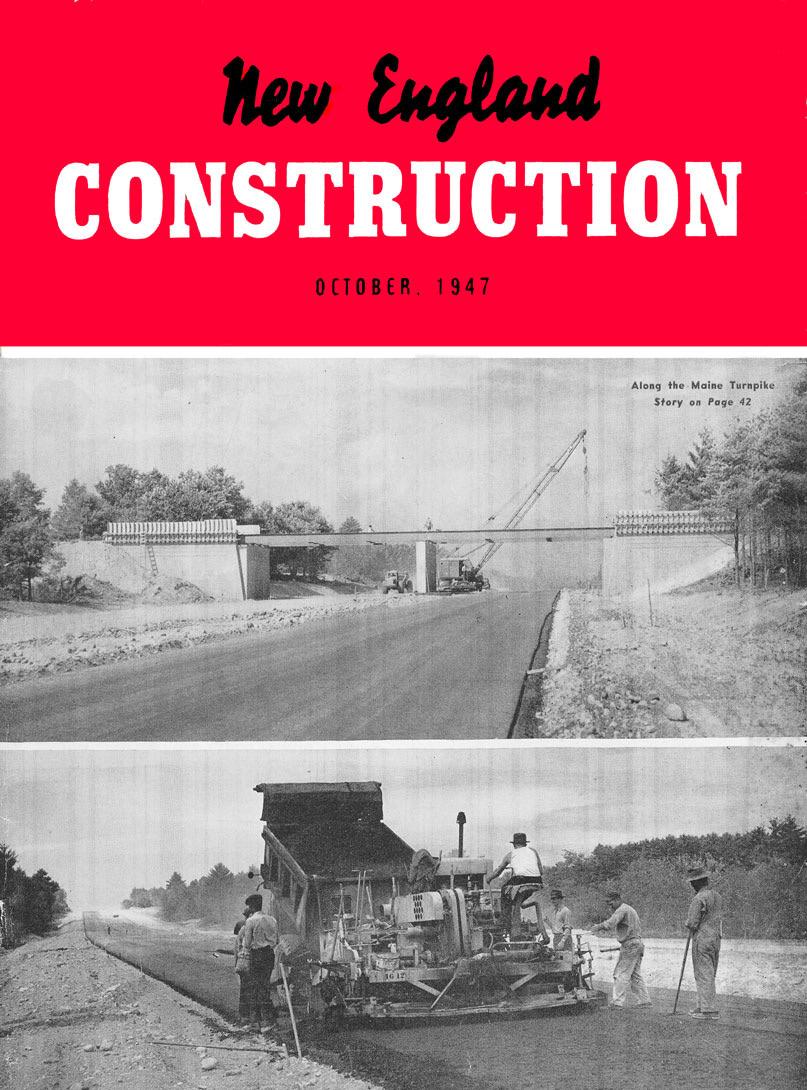





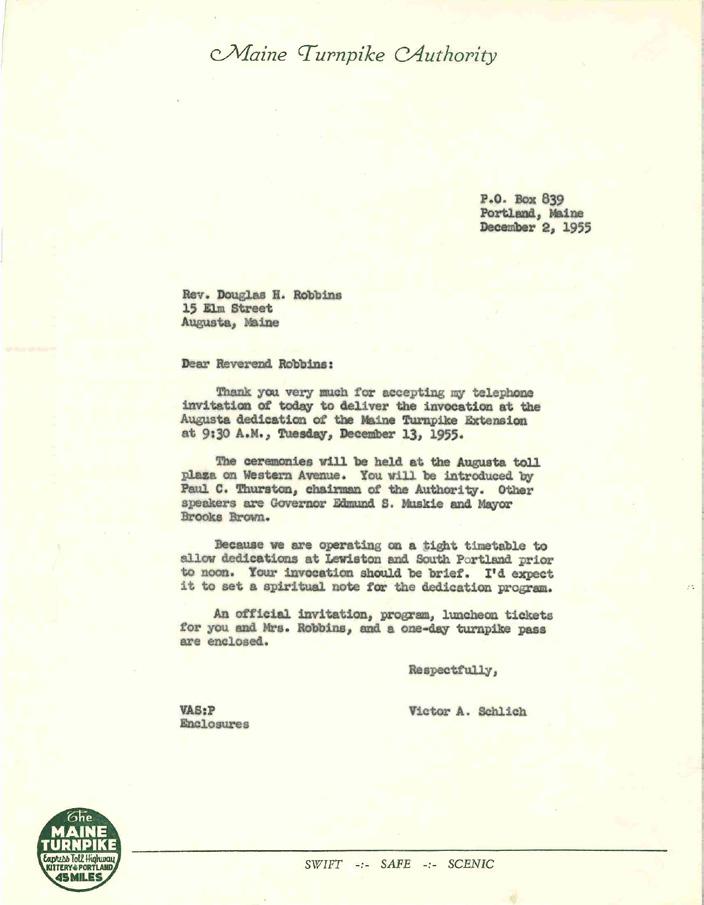














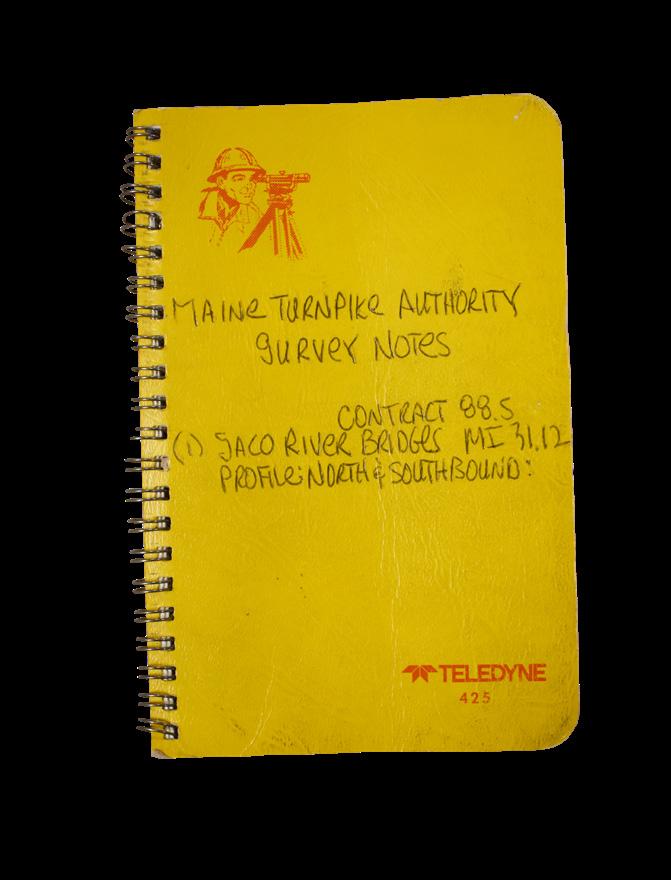












The Maine Turnpike Authority would like to thank all of the firefighters from 15 community fire departments that responded so quickly to last Thursday’s fire at our Academy Road





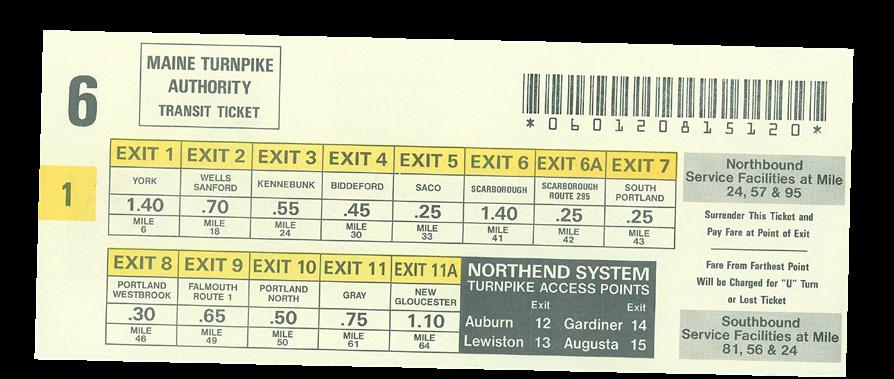
6,995 MAINE HEROES BEHIND OUR GOLD
The Maine Turnpike Authority salutes all of America’s military veterans and reminds freedom loving people everywhere that the Turnpike is officially Gold Star Memorial Highway in remembrance of Maine’s 6,995 veterans gave their lives in defense of our country and the families they left behind.
MAINE TURNPIKE BOARD OF DIRECTORS
Daniel E. Wathen, Chair Kennebec County
Robert D. Stone, Vice-Chair Androscoggin County
Michael J. Cianchette, Member Cumberland County
Jane L. Lincoln, Member Kennebec County
Andrew McLean, Member - Term began April 2022 Cumberland County
Ann R. Robinson, Member - Term ended March 2022 Cumberland County
Thomas J. Zuke, CPA, Member York County
Bruce A. Van Note, Commissioner, MaineDOT Ex-Officio Member
Peter Mills, Executive Director
Douglas D. Davidson, Chief Financial Officer & Board Treasurer
Peter S. Merfeld, P.E., Chief Operating Officer
Jonathan A. Arey, General Counsel & Board Secretary
Tim Cote, P. E., HNTB, Consulting Engineer

ACKNOWLEDGMENTS
The Maine Turnpike Authority would like to thank the following individuals and organizations for their assistance in preparing this 75th Year Commemorative Brochure and our MaineTurnpike75.com Website.
Produced by Woodbury & Morse
Writer/Creative Director – Tom Morse
Designer/Illustrator – Charlie Jacobsen, Jacobsen Design
Editors – Erin Courtney and Rebecca Grover, Maine Turnpike Authority
Photography – David Bates, MaineDOT, Andy Ryan
Archival Photography – Caribou Public Library, Dyer
Library Archives/Saco Museum, Hartland Historical Society, Kennebec Public Library, Maine Historical Society, Maine Turnpike Authority Historical Records, McArthur Public Library, Osher Map Library and Smith Center for Cartographic Education at USM, and Seashore Trolley Museum
Archival Film – Michaud Family Film Collection, Northeast Historic Film
Videography – Maine Imaging
Historical Vignette Editing – The Edit Shop
Interview Videography/Editing – Catama Productions
Audio Recording – ProComm Voices
Web Development – Flyte New Media

“A final word of thanks to every person who helps to make the Maine Turnpike run and a special thankyou to the tens of millions of drivers a year who choose to travel with us. As always, wherever you travel, thank you for your safe driving.”



